This week’s Premier League round of fixtures ended with a huge clash between Chelsea and Manchester United. When these two teams played against each other in the first game of the season, Ole Gunnar Solskjær’s team stormed to score four goals and win easily. With more than half the season having gone by, both teams have had their ups and downs, and Frank Lampard’s team were looking for revenge at Stamford Bridge.
Again, VAR became a controversial talking point, as the goals of Kurt Zouma and Olivier Giroud were ruled out. Eventually, United secured a two-goal victory in this important game, thanks to goals from Anthony Martial and Harry Maguire.
This was a tight match where the pressing strategies of both teams were the most important elements of the game. In this tactical analysis, we will show you how United beat Chelsea. It is an analysis that focuses on tactics.
Lineups
Lampard’s team played in a 4-3-3 formation. Callum Hudson-Odoi and Tammy Abraham were unavailable, so the front three was formed by Pedro Rodríguez, Willian and Michy Batshuayi. Andreas Christensen started ahead of Zouma and Fikayo Tomori, partnering Antonio Rüdiger at the centre of the defence. In goal, Kepa Arrizabalaga was left on the bench and Willy Caballero started.
Solskjær used an intriguing 3-4-1-2 formation. Their new signing, Bruno Fernandes has increased the flexibility of the manager to tune his tactics. He was behind Daniel James and Martial. The back three of United was formed by Luke Shaw, Harry Maguire and Eric Bailly; Brandon Williams was playing as a left wing-back.
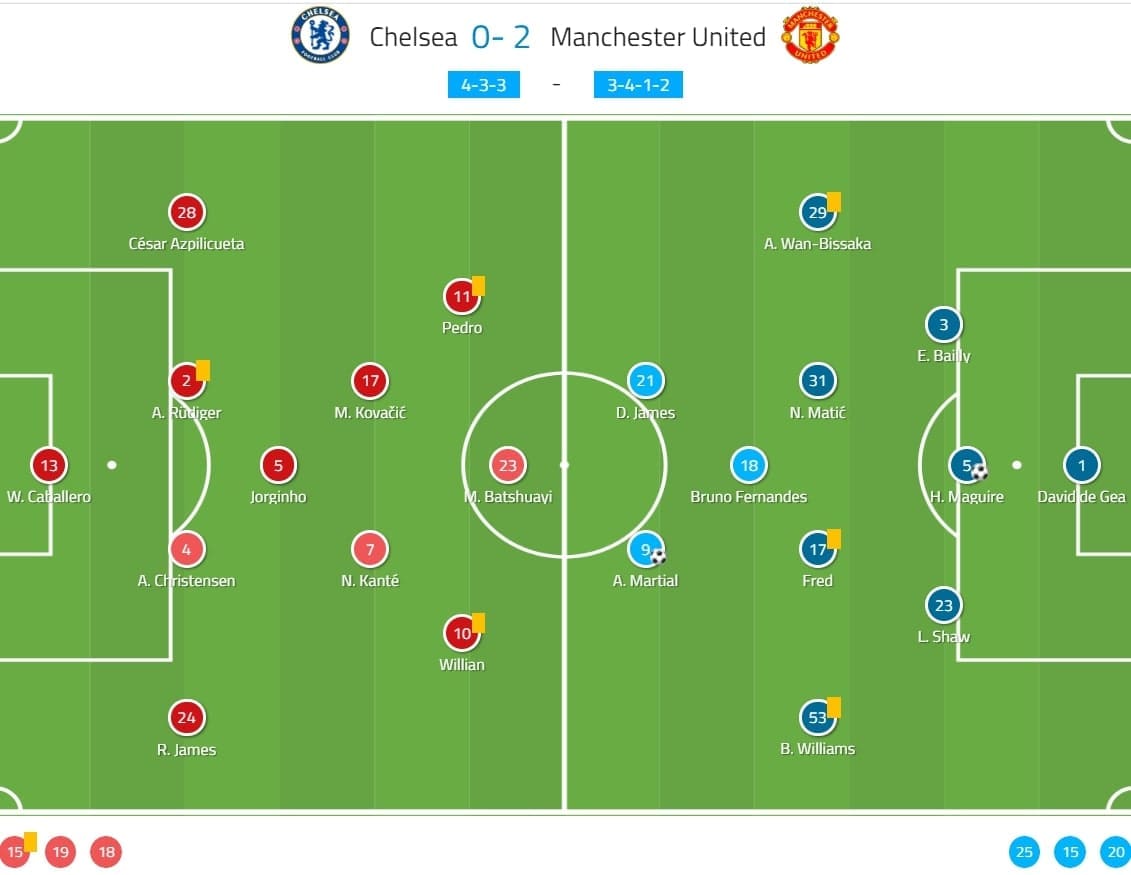
Chelsea: pressing and spacing
This was a game full of pressing. Lampard adjusted his pressing strategies so as to avoid the shortcomings seen in the first league game. At Old Trafford, United utilized the spaces between Chelsea’s lines and generated many chances behind the exposed defenders. Lampard tried to increase the compactness of the lines by adjusting the midfielders’ positions.
Mateo Kovačić had to choose his positions smartly in this game. He could have two options when defending.
- Staying with the right midfielder and man-marking a United pivot
- Dropping deeper to cover Jorginho or the space.
Numerically, both Chelsea and United had three players at the midfield. Thus, theoretically at least, these three players man-marked their targets when defending (Jorginho – Fernandes; Kovačić – Nemanja Matić; Mason Mount – Fred). With Kovačić’s positioning and marking, Chelsea tried to not let United play behind Jorginho easily.
As for the full-backs, they were instructed to step out early. Lampard wished to deny United opportunities to play out from the back through the wide players. As highlighted below, when Aaron Wan-Bissaka received the ball in his own half, he confronted Cesar Azpilicuéta, who shut his vertical passing lanes. United could hardly develop meaningful chances when they gave the ball to their wing-backs.
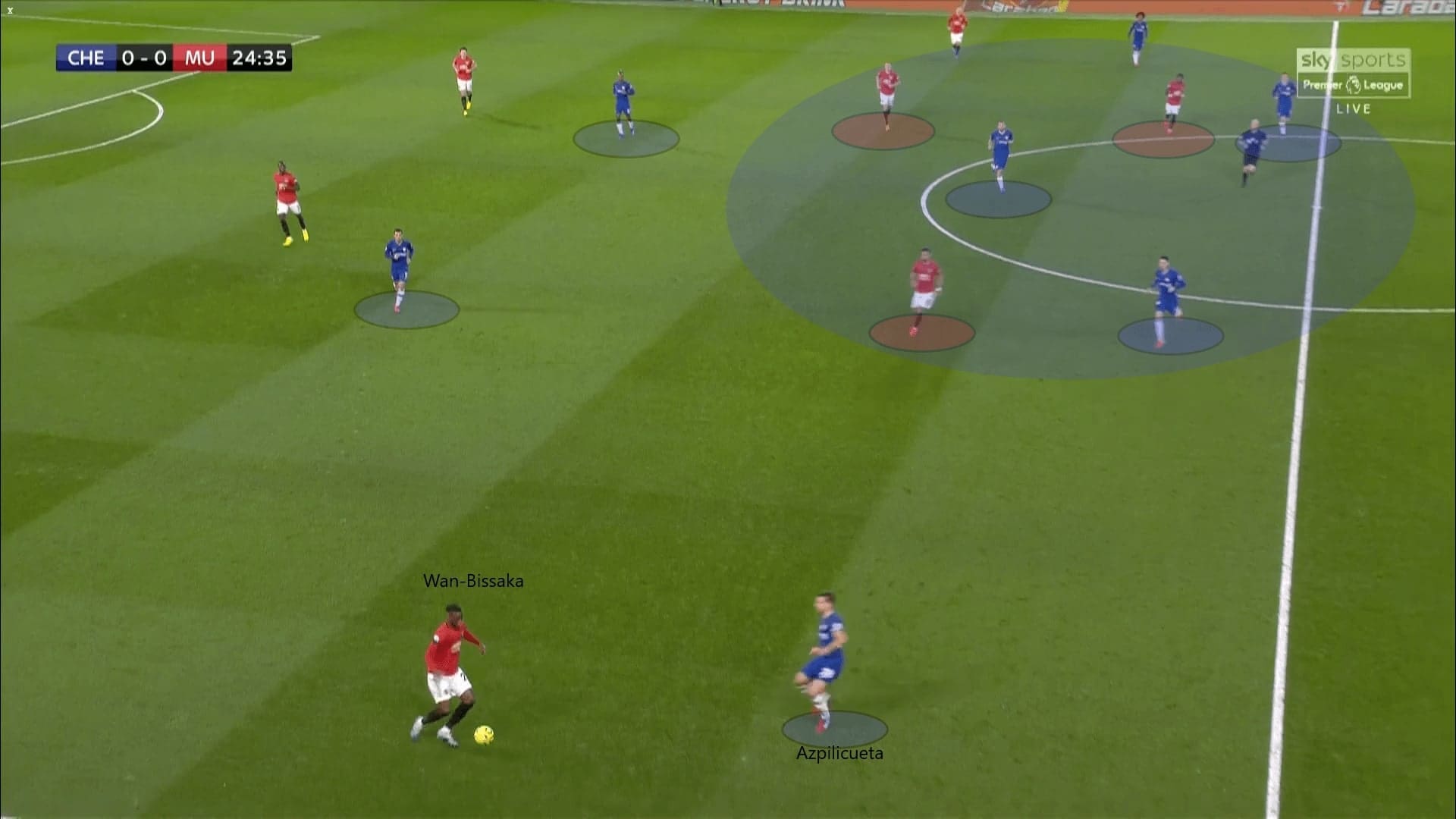
We believe the early injury of N’Golo Kanté disruptedLampard’s setup. The Frenchman was a better pressing player when compared to his replacement, Mason Mount, even in an advanced position. With the former Leicester City man, Chelsea could protect Jorginho better through their advanced pressing.
Mount did not offer the same defensive contribution as Kanté did. Therefore, United penetrated through the centre on some occasions. In this image, we look at two issues of Chelsea’s defence.
- Defensive awareness of Jorginho
Shutting the passing lanes in midfield is not a strength of the Italian; his tended to focus on the ball more and move forward. In this situation, it seemed as if he forgot about the presence of Fernandes. Fred easily passed through the gap between the Chelsea midfielders to find the Portuguese.
- Numerical dilemma
When Kovačić dropped beside Jorginho, Chelsea could not man-mark United’s pivots due to the deep and close positions of Matić and Fred. As, in this case, Mount was pinned by Matić, and Fred enjoyed time and space to pass without pressure.
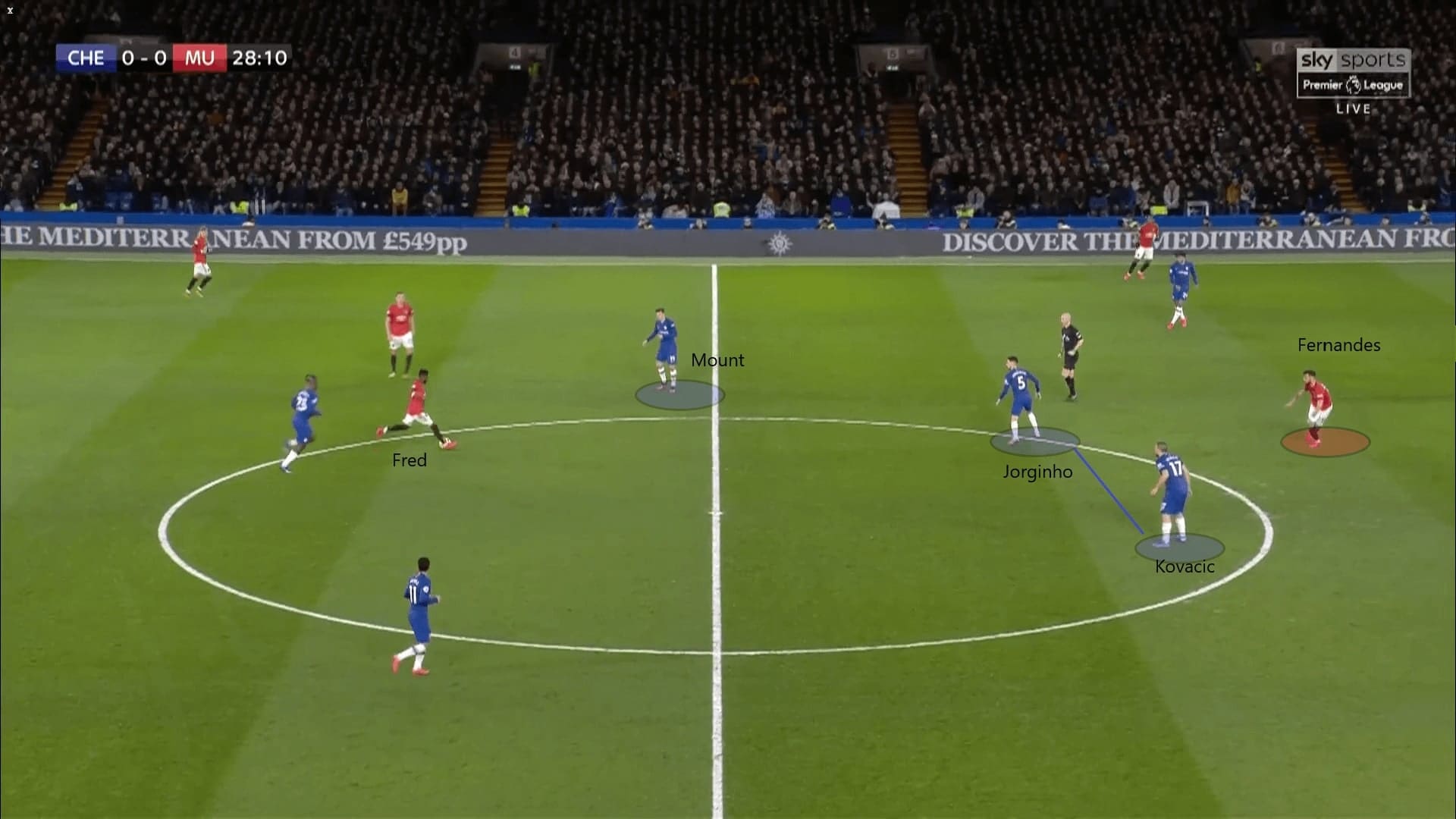
Despite the issues of Chelsea’s defence as mentioned, they were slightly unfortunate to concede the first goal before half time. Their defensive system was unavailable at that moment. Jorginho had dropped into the defence as a result of Christensen’s bleeding nose.
When the Danish international returned to the pitch, Jorginho was slightly too late to push forward and fill the midfield. Fernandes, who should have been marked by the Italian, dropped deep and pinned Kovačić. Because of this, Fred became a free player to exploit the space in the centre and developed the attack that led to the goal.
Of course, when we speak of individuals, both centre-backs (Rüdiger & Christensen) shared the responsibility. For the German, his positioning gave Martial the space to attack and the Dane was not marking him tightly enough.
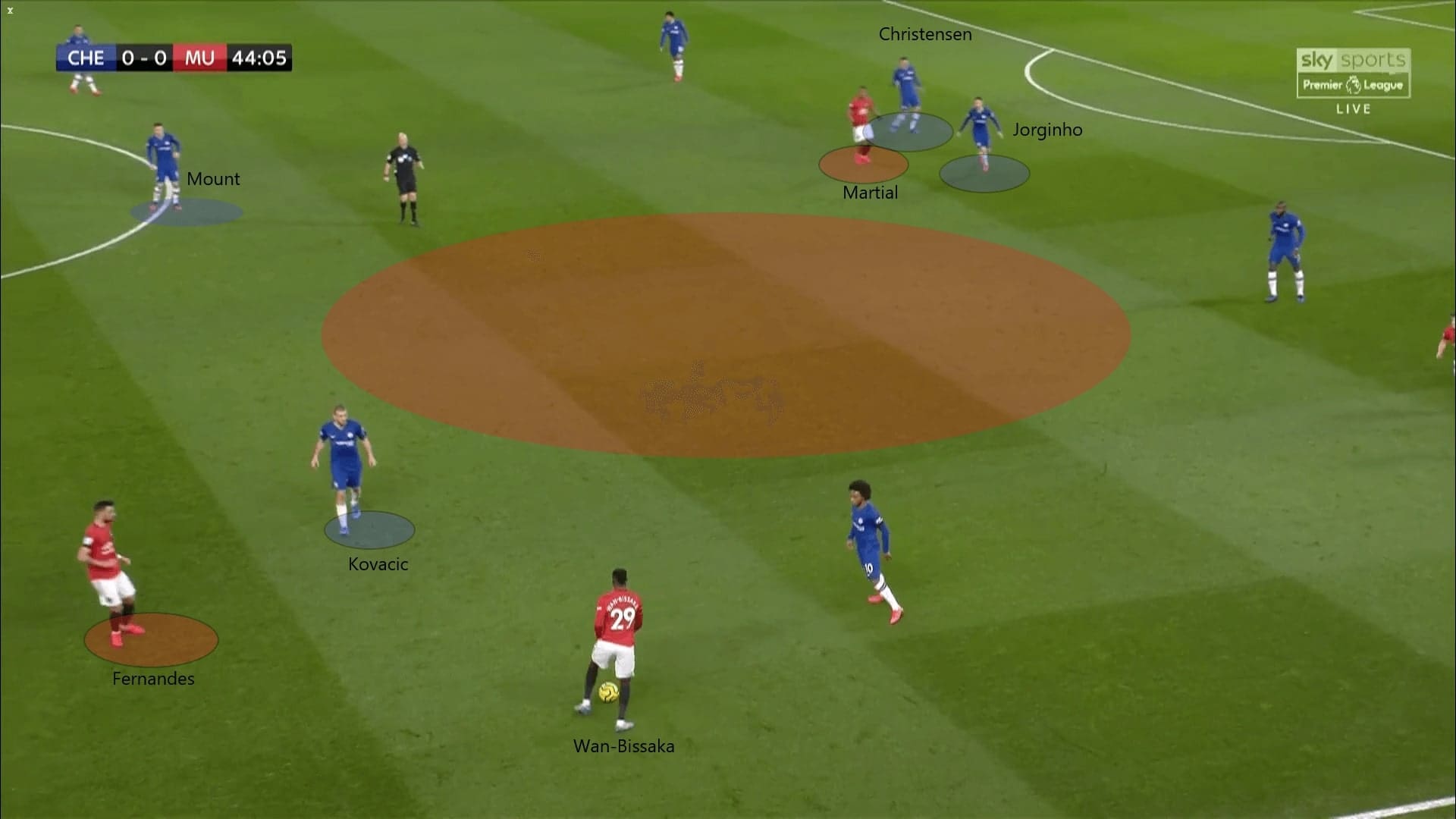
United’s attacking style of play
With Fernandes’ arrival, Solskjær had more options to choose his tactics as the Portuguese player is cleverer and more experienced than Andreas Pereira. The former Sporting CP man was the man of the match, with an 81% pass completion rate from 36 passes; one key pass; three shot assists and two shots.
Below is the heat map of Fernandes. Despite playing as an attacking midfielder, he did not merely stay in zone 14. Instead, almost every area on the pitch had his touches. He showed up in the left half-spaces on most occasions, as this was the focus of United’s attack which we are going to explain.
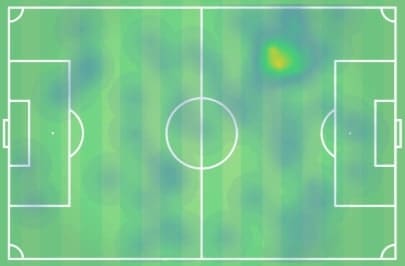
Solskjær had a clear plan in his mind on how to attack against Chelsea. The main theme was to get their best offensive players (Fernandes; D. James; Martial) on the ball. He identified the right side of Chelsea’s defence, where the defenders were Christensen and Reece James as the focus of the attacks. It was a conceivable decision as the combination of Rüdiger and Azpilicueta was an experienced and physically stronger defence.
United tried to use their left wing-back (Williams) to provoke the press from R. James. This was usually the case, as explained, Lampard instructed his full-backs to step out early. Martial made diagonal runs behind the Chelsea right-back as soon as R. James closed Williams. The Frenchman was very likely to confront Christensen, as Chelsea would switch to a back three with Azpilicueta inverted. This created favourable conditions for his teammates:
- Fernandes
The Portuguese was free to make runs behind Jorginho or to support Martial on the left. He also swapped his position with the Frenchman when Martial dragged Christensen out to the left.
- James
For James, he stayed narrow in the centre. As Christensen left the defensive line, the horizontal distance between Chelsea’s defenders increased. He could use his pace to run between Rüdiger and Azpilicueta, or show up as a central outlet in zone 14.
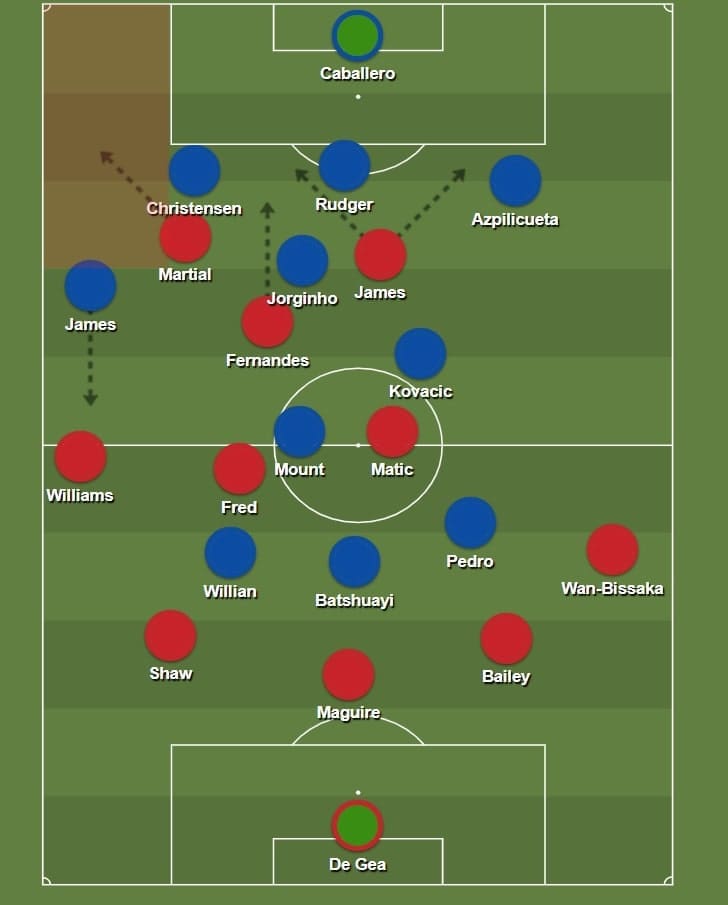
Below is an example, though the players were different from the above image. On this occasion, Matić played a vertical pass comfortably to reach the front three because of the numerical dilemma as explained. Also, R. James left his position to close Williams. The Chelsea defenders were far from each other. Again, Jorginho failed to shut the passing lanes or cover the spaces behind him quickly.
In this case, it was James in the centre, Martial on the flank, supported by Fernandes at their right. With the huge spaces behind R. James, Martial was released by D. James and reached the box to shoot.
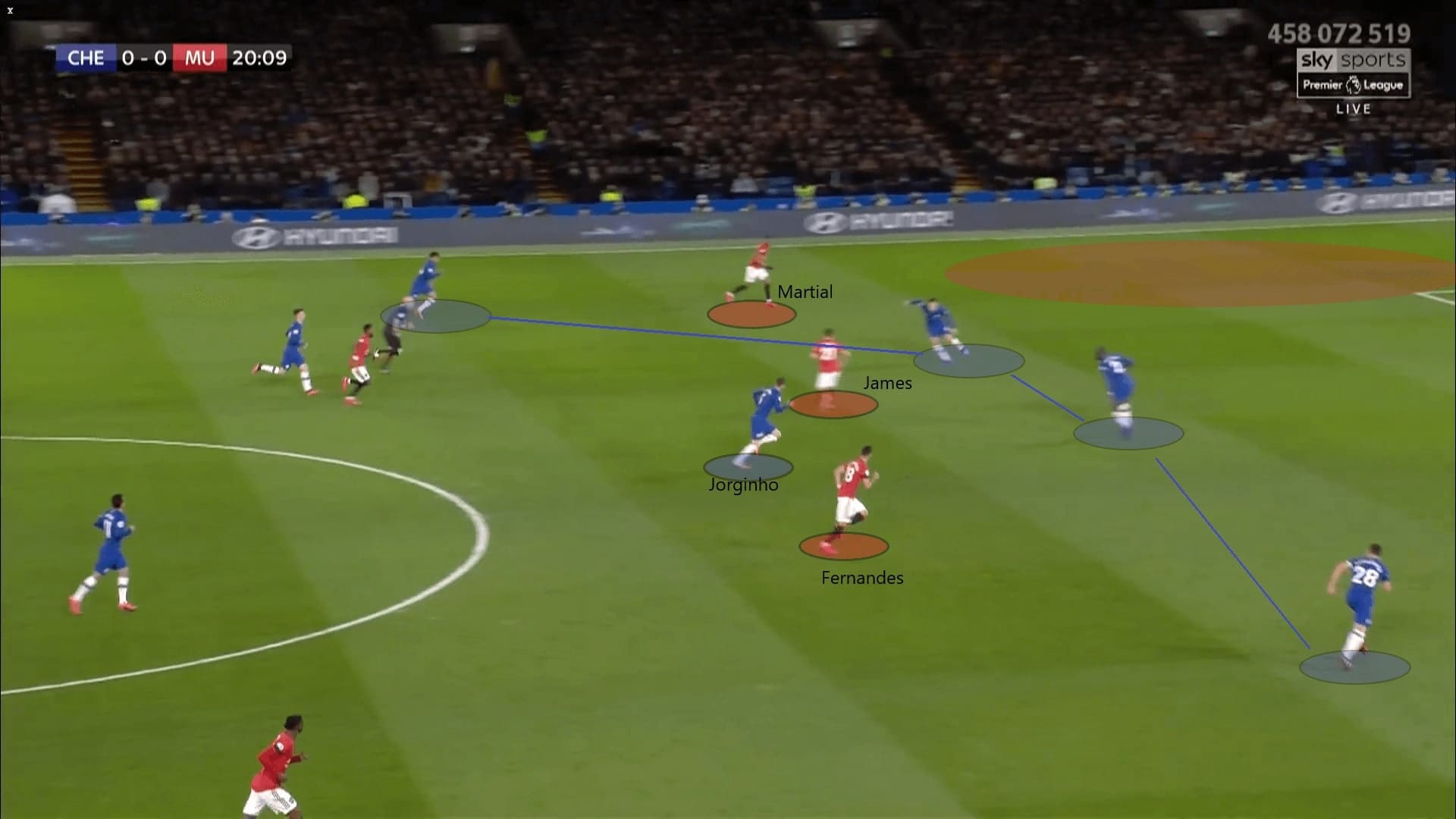
For another reference, this demonstrated the loose marking of Jorginho on Fernandes. United tried to overload the left flank with Martial providing the width and Williams occupying the half-spaces. The positioning of United’s left wing-back took R. James away from the Chelsea defenders again.
Fernandes is a clever player who identifies the spaces and times his runs correctly. In this situation, he ran on Jorginho’s blindside. The Italian did not cover the space between his defenders or track the run. Again, United access the box and created a shooting chance.
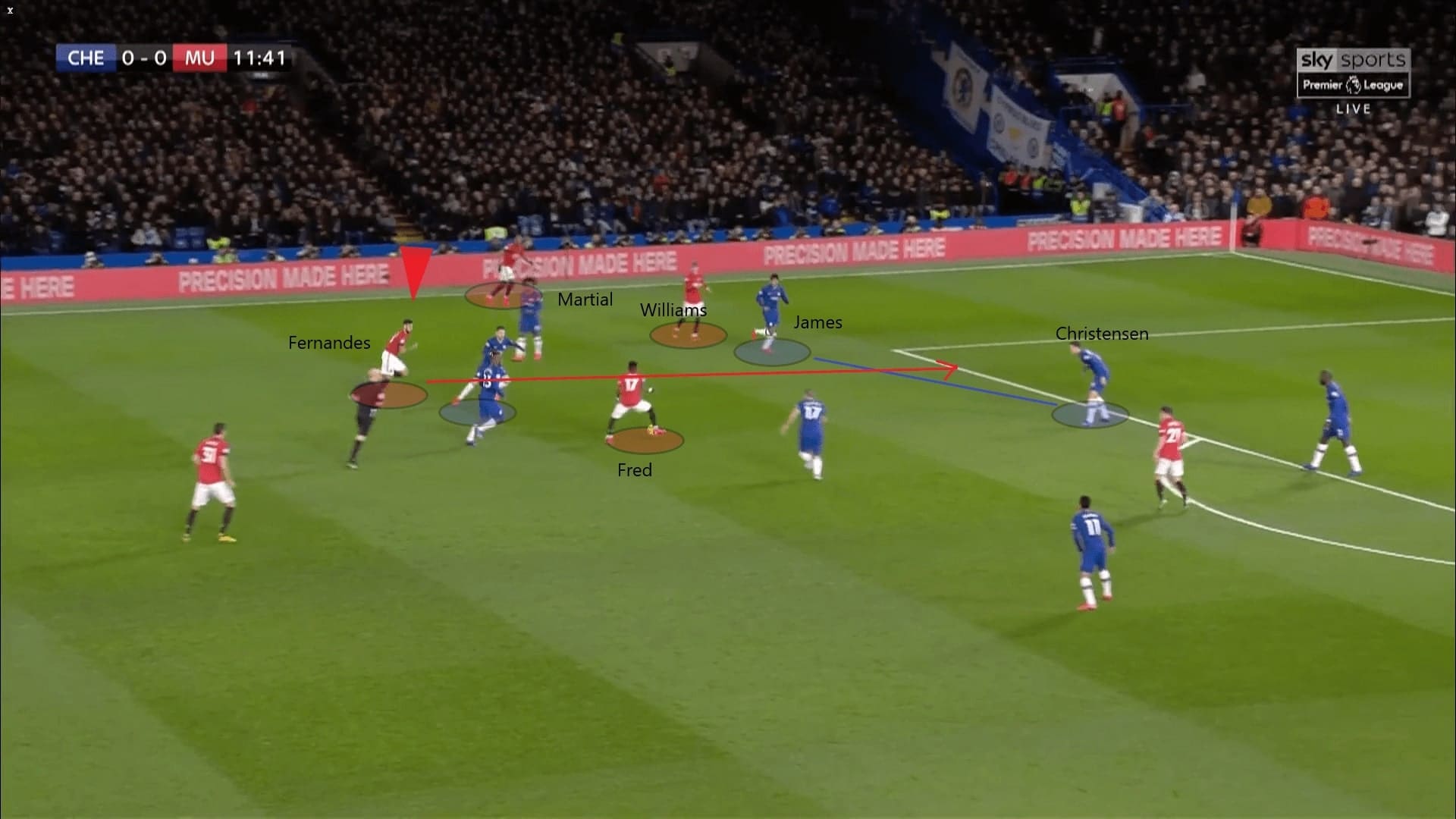
Press and low block of United
United pressed high to disrupt Chelsea’s build-up. It was a man-marking approach and Solskjær’s men reached numerical equality in different areas.
The first line of their press was formed by the front three (Martial – Christensen; Fernandes – Jorginho; D. James – Rüdiger). Considering the midfield, United also had the same number of players as Chelsea and thus they marked both Blues’ midfielders tightly. Usually, when Kovačić dropped to support the build-up, he had a player behind his back which meant that he could not turn quickly.
A benefit of playing two left-backs was the flexibility when defending. Solskjær instructed his wing-backs to confront the Chelsea full-backs early; on the left, even if Williams approached R. James early, United could switch to a back four comfortably with Shaw moving wider. The back three of United marked the front three of Chelsea, following them if they dropped too deep.
However, an underlying drawback of this system was the space left behind the wing-backs. Since Wan-Bissaka and Williams left their position, this also generated some huge spaces behind them on both flanks.
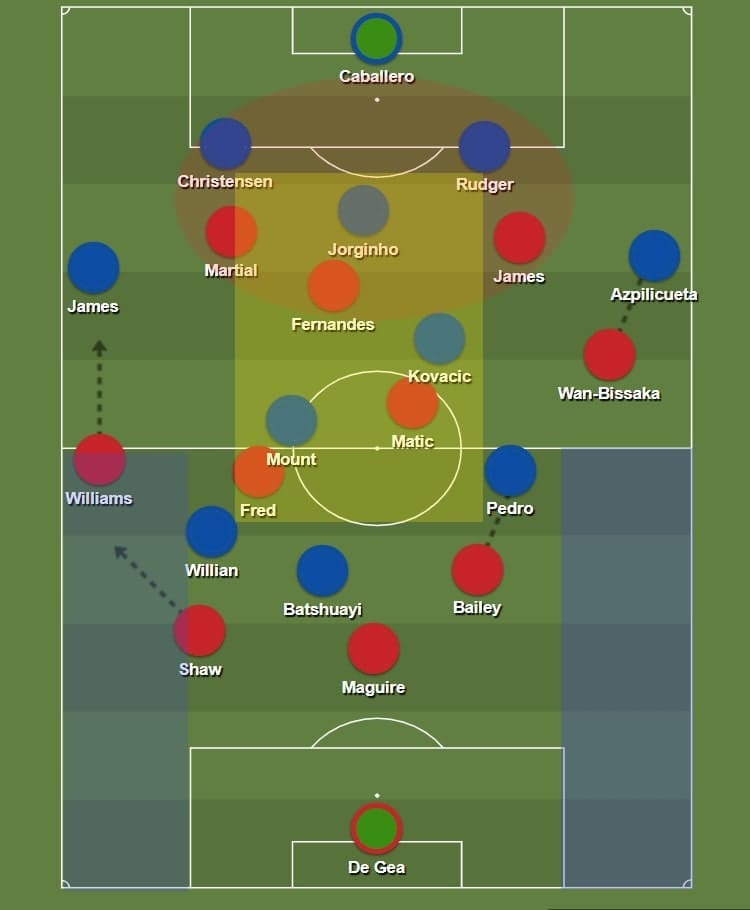
Chelsea created their chances through exploiting the flaws of this approach in the first half. In this example, Wan-Bissaka was pinned by Azpilicueta. Despite stepping out early to mark Pedro, Bailly failed to intercept or block his pass; Fred merely focused on the ball and he forgot Mount’s run. United’s defence lost shape in that instant; Chelsea exploited the gaps between the lost shape defensive line and created a shooting chance in the box.
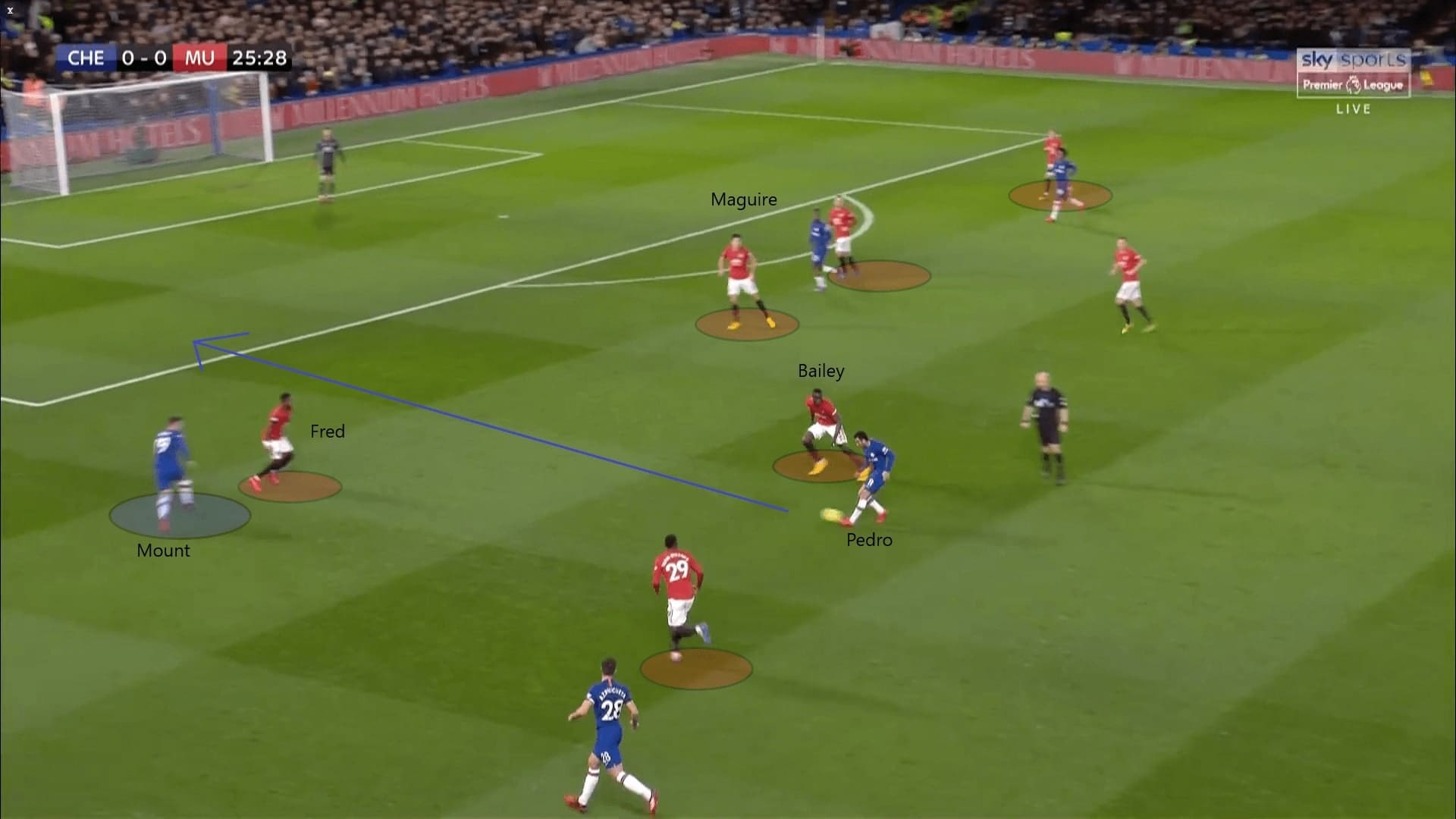
As United had a two-goal lead, they sat deeper and defended with a low block in the latter stages of the game. Their 3-4-1-2 formation gave them a numerical advantage to defend on the flanks, as well as the flexibility for the defenders to step out. Chelsea could not break the low block.
This is illustrated in the following image. United had six players on that flank. The tracking of a front player (Martial), stepped out central defender (Bailly) and both pivots caged Pedro. Another benefit of this approach was the coverage of the low block. In case Pedro tried to release Mount and Wan-Bisska was beaten, United still had Maguire to cover. On the far post, Giroud was not isolated, United had two players (Shaw and Williams) around the Frenchman.
Also, they did remarkably well to block the shots of Chelsea. The Blues’ had 16 shots in this game. Amazingly, 10 of them were blocked by the Red Devils (six in the box), including a 0.44 xG shot from Kovačić.
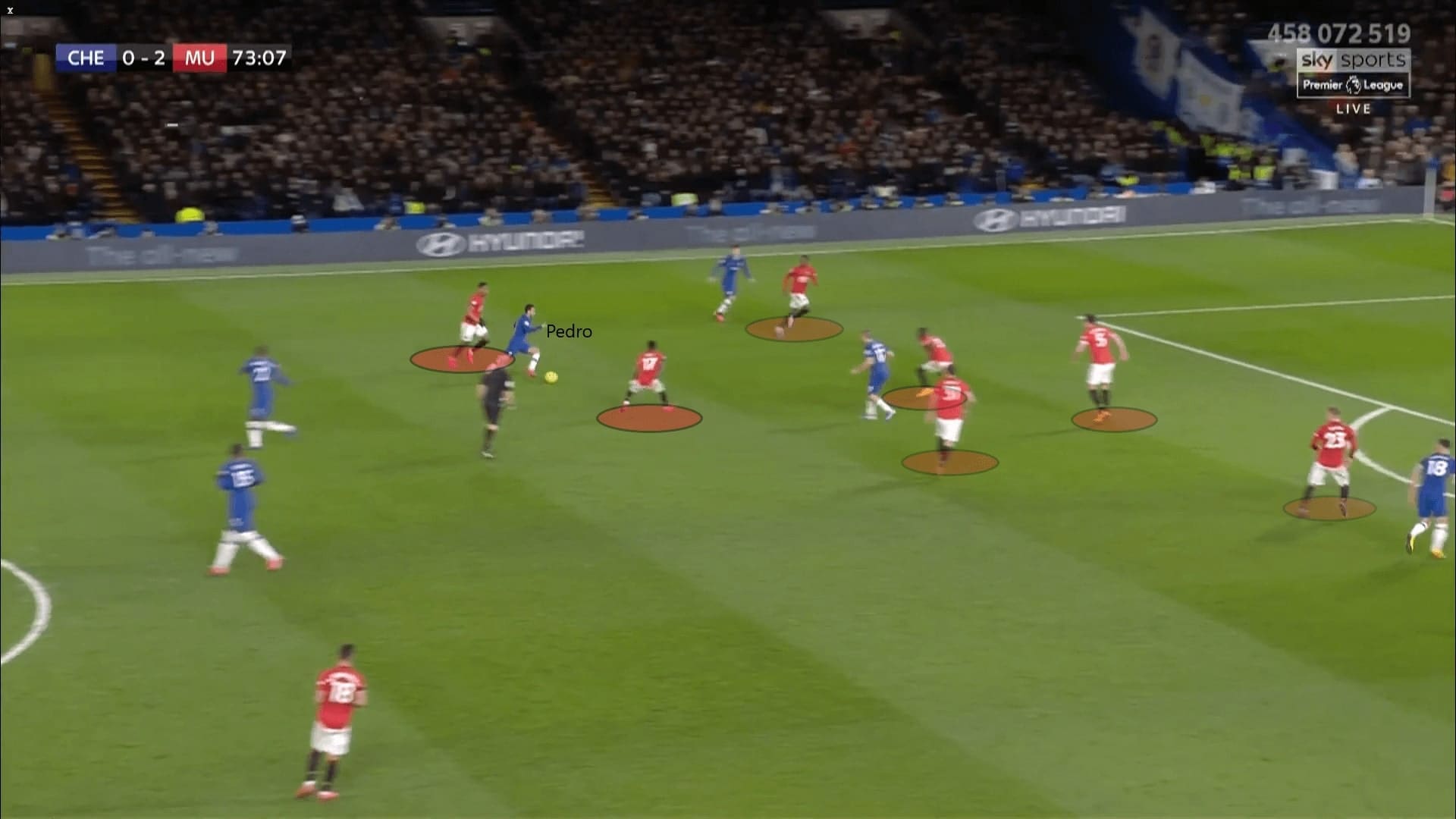
Chelsea’s attacking issues
In this section, we further elaborate on the inefficacy of Chelsea’s attack. First, we begin with how they failed to exploit the spaces behind the wing-backs. The below pass map of Pedro provides some hints. The former Barcelona winger had a decent passing record, completed 44 passes out of 50. However, when we looked at his passing direction at the central third, a large proportion was backward passes and lateral passes. Furthermore, he had no successful dribbles in the central third.
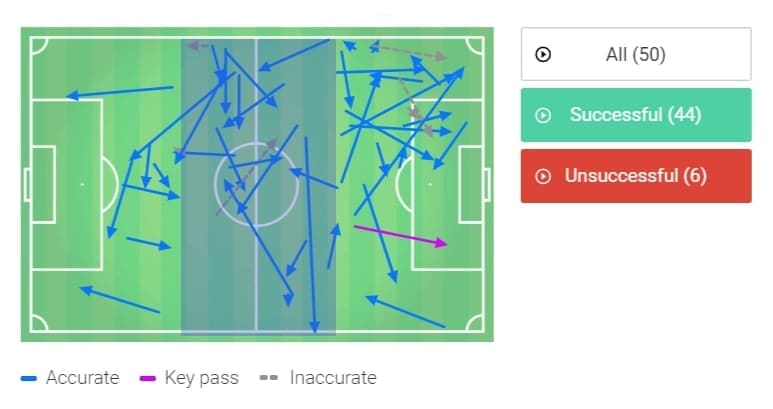
The reasons for Chelsea’s unoptimized attacks were twofold.
- Pedro himself
In the first half, Pedro dropped too deep; he did not exploit the spaces behind Wan-Bissaka. As shown in the following example, he positioned himself in the half-spaces, but Azpilicueta was looking to go long.
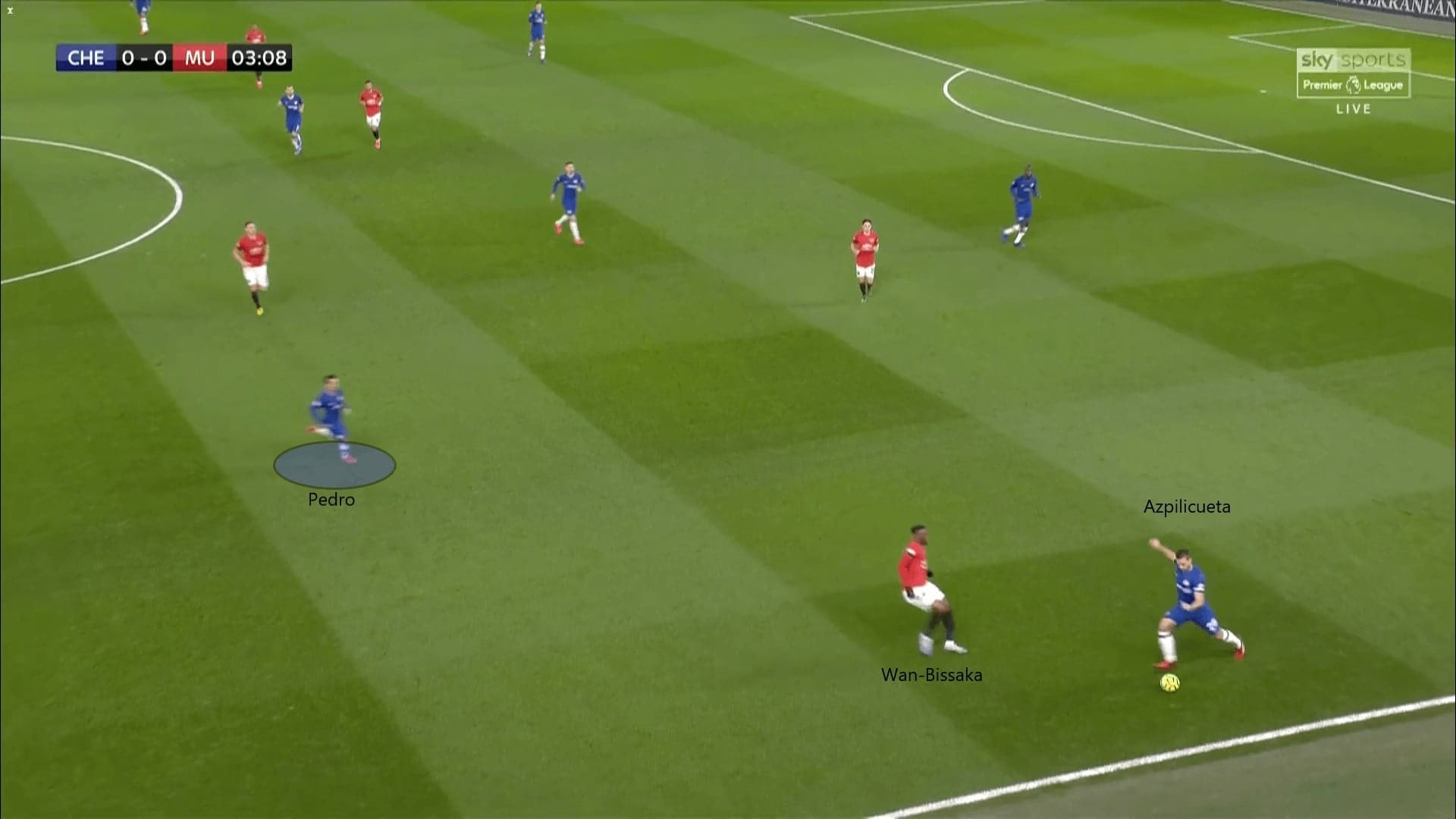
Also, as a right-footed player looking to play on the right flank, his body orientation was closed at the moment he received the ball (as shown below). Also, Bailly was behind him for most occasions, and given the physical mismatch, Pedro tended to return the ball as he could not turn.
- Batshuayi’s positionings
Even though Pedro’s dropping movement took Bailly away from the defensive line, Batshuayi showed no inclination to exploit the spaces behind the Ivorian. He often positioned himself in the centre, where Maguire was around him. The Belgian should ideally have gone to the wide areas, behind the wing-backs, as those were the spaces generated by his teammates. As shown below, Batshuayi was still in the centre when Pedro received the ball.
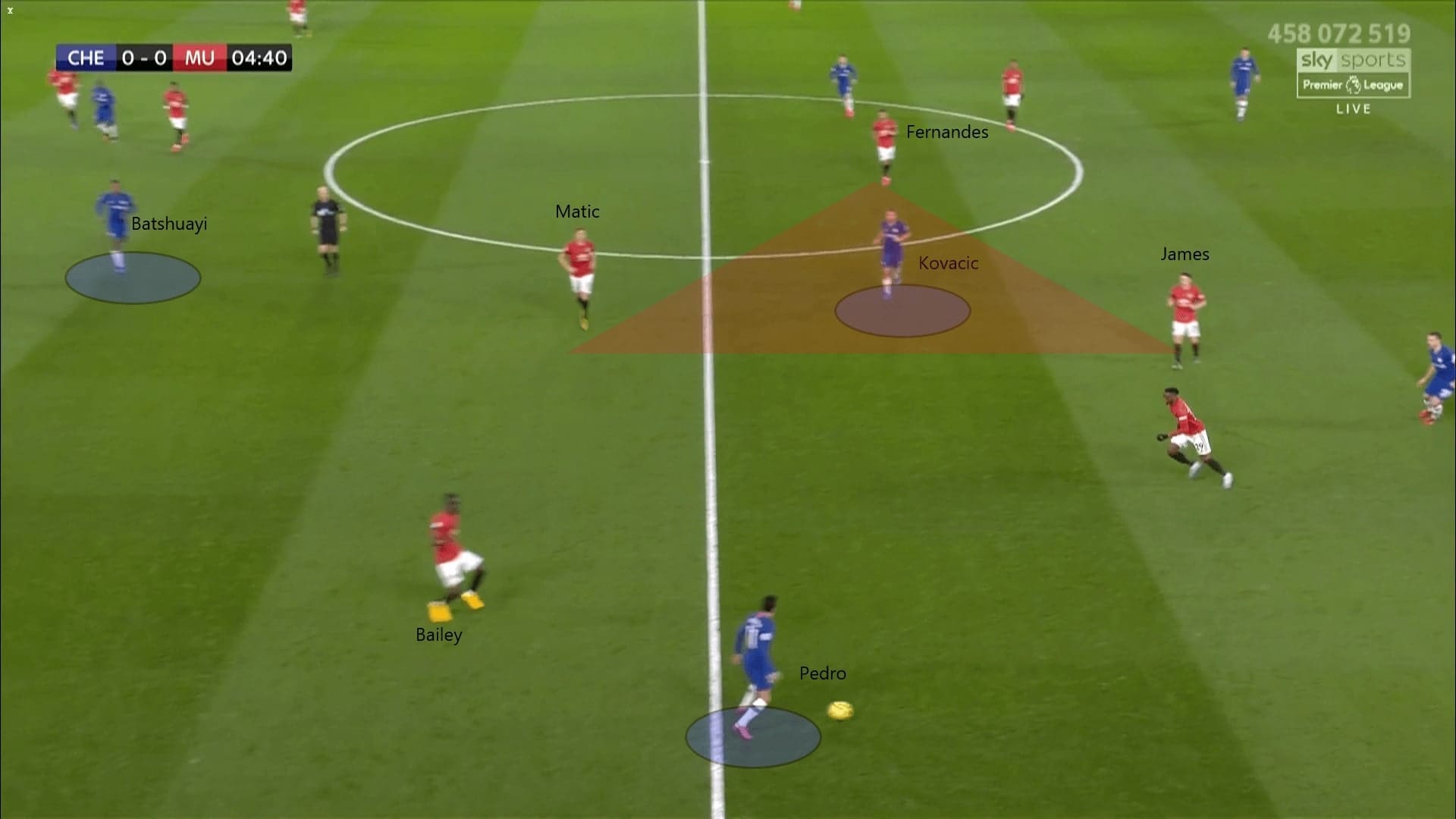
On some occasions in the second half, Chelsea won the numerical advantage in the first phase of attack since United’s pivots did not join the press. So, when Kovačić dropped, Chelsea had a numerical superiority of four-v-three at the centre. As shown below, the Croatian pinned Fernandes while Martial and James confronted the centre-backs. As a result, Jorginho was free from pressure.
However, this did not help Chelsea’s build-up play too much, as the marking on Mount remained tight. For Willian, he tended to stay in the half-spaces and let R. James attack the flanks. Given the cramped central areas as illustrated with the low block of United, Jorginho could not penetrate through the centre.
For R. James’ runs, it was slightly late for him to reach zone 18 as he started from a deep position. Also, the run was easily tracked by Williams.
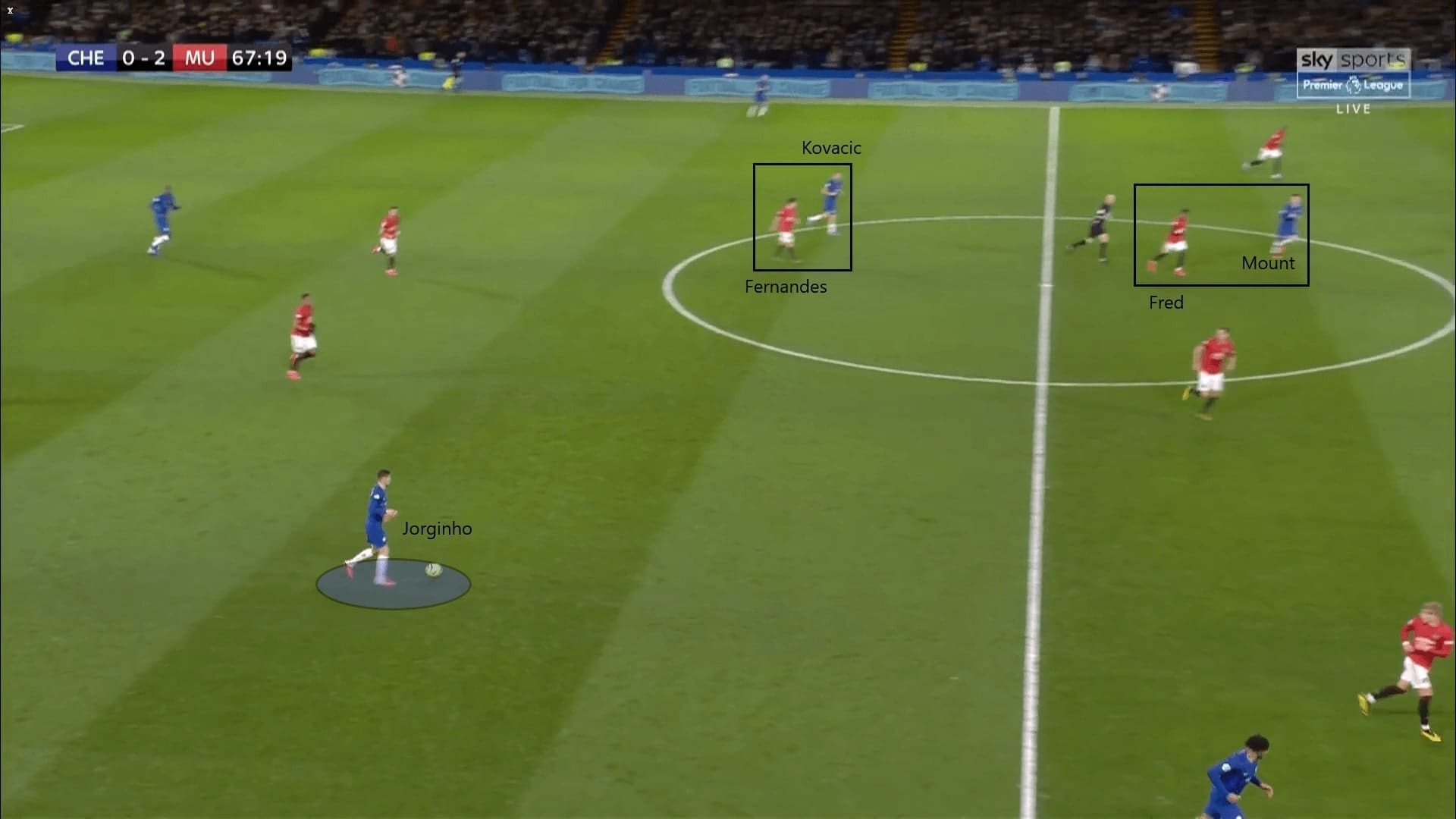
Apart from the failures to convert chances, Batshuayi also failed to serve his team as a target man. The Belgian merely won two of his seven offensive duels. It was easy for Maguire to intercept the ball.
The introduction of Giroud brought some changes to Chelsea’s attack. The experienced Frenchman possessed physical superiority; he could hold the ball under pressure and create third-man combinations with his teammates.
The below image is an example. Giroud used his body to separate Maguire and the ball and returned it to Kovačić: the third-man. Since the Croatian was facing the goal, he could clearly identify his passing options. This time, Pedro exploited the spaces behind the wing-back and was released by Kovačić.
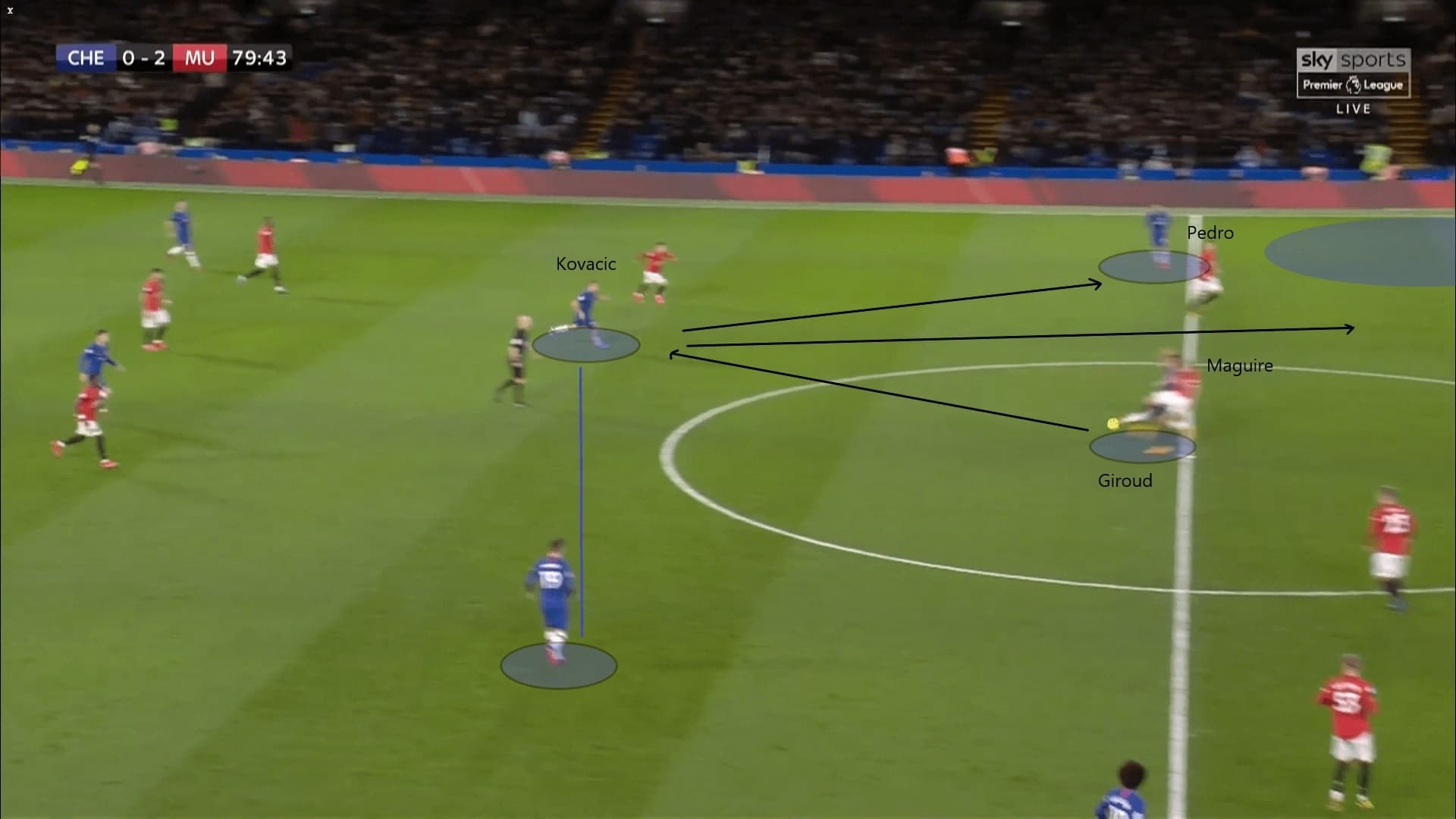
Reoccurring corner tactics which led to the goal
Fernandes recorded his first assist at United with his delivery for Maguire’s goal. We wrap up this analysis with the tactics of United’s corners as the last section. The goal from United’s new captain was not a coincidence, as, before the goal, there were many similar events that hinted at how the Red Devils attacked with corners from the left.
No matter if it was Fred or Fernandes to take the corner, the theory remained the same. United tried to create large spaces at the far post via the positioning of the players. Maguire and Bailly, the two physically strongest players of United, were the focal points of the corners. Their task was to stay at the edge of the box, creating a two-v-two situation against two markers, then, use their physical superiority to head the ball.
As demonstrated in this image, Baily and Maguire were in a two-v-two against Christensen and Azpilicueta. Meanwhile, United’s players manipulated the Blues to the front post with their movement. Both centre-backs were clear that the objective was to attack the spaces at the far post. No matter whether it was an out-swinging or in-swinging corner, as long as the ball reached that area, it was a good chance for United.
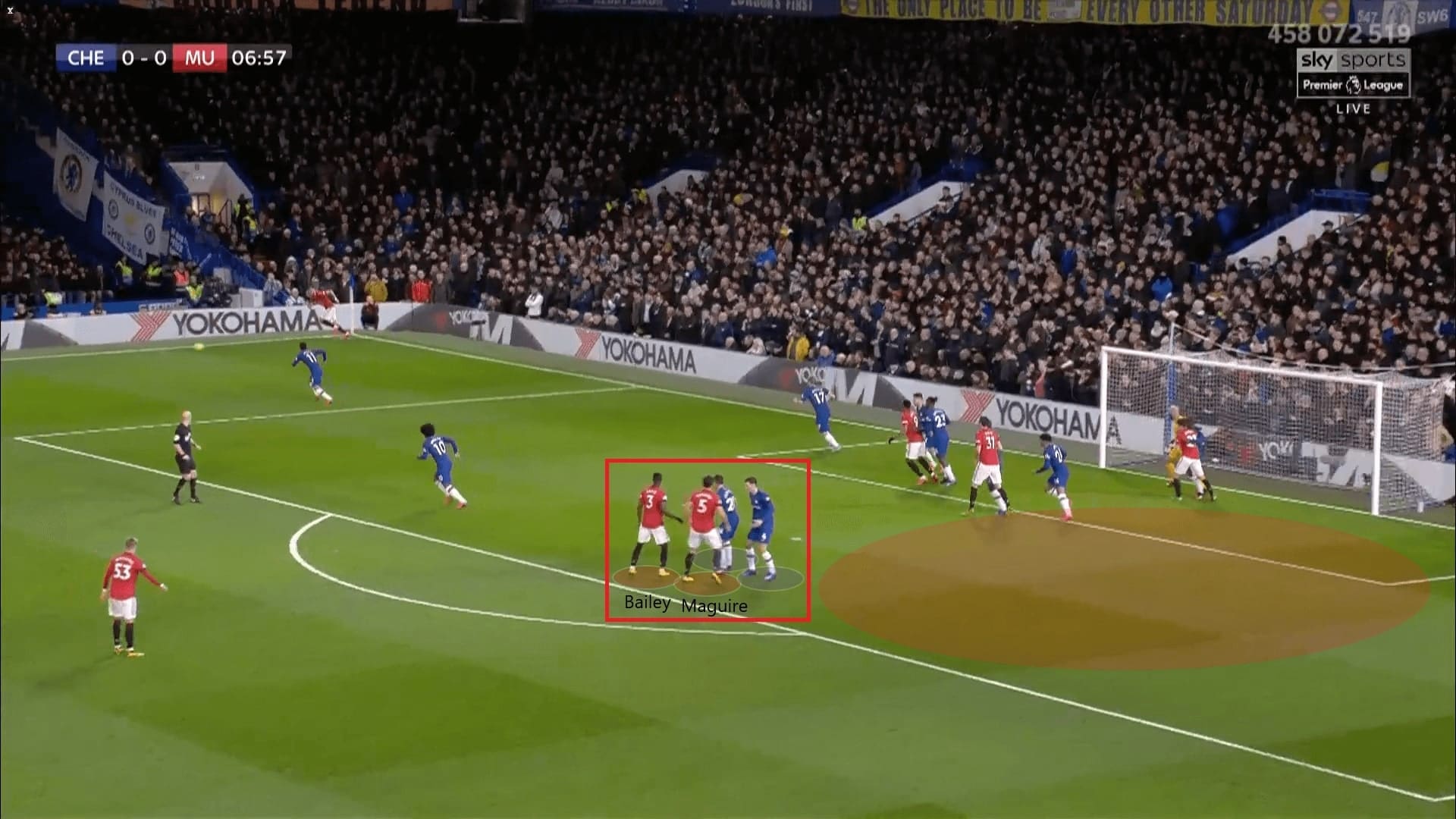
Conclusions
After the game, United reduced the gap to Chelsea to three points, while they are in seventh place in the league. The signing of Fernandes has made an instant impact on the team, providing another solution to United’s attack other than playing long. Defensively, despite the flaws of their systems, Chelsea did not exploit the spaces with their build-up play. Their 1.57 xG was slightly misleading, as there was no huge chance except the one from Kovačić. With Abraham’s absence, Lampard might want to decide between playing Giroud over Batshuayi as the Belgian’s performance was far from satisfactory. The Belgian lacked confidence and sharpness in front of goal.




Comments